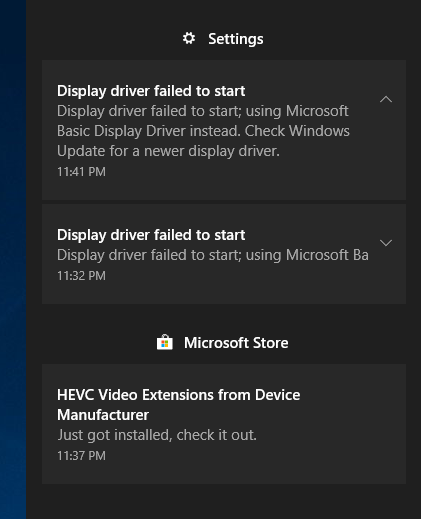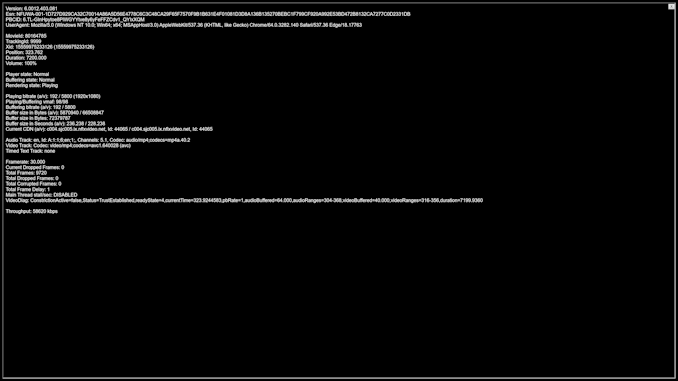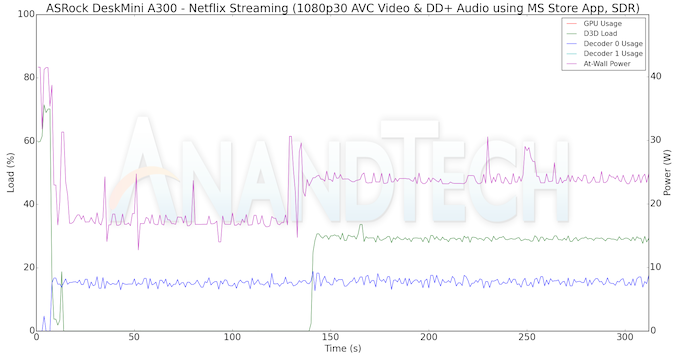The ASRock DeskMini A300 Review: An Affordable DIY AMD Ryzen mini-PC
by Ganesh T S on April 26, 2019 8:00 AM ESTHTPC Credentials - YouTube and Netflix Streaming
Streaming of 4K OTT content with YouTube and Netflix has become mainstream. HDR displays have also started becoming affordable. In order to evaluate YouTube HDR streaming support, we have the Mystery Box's Peru 8K HDR 60FPS video as our test sample. On PCs running Windows, it is recommended that HDR streaming videos be viewed using the Microsoft Edge browser after putting the desktop in HDR mode.
HDR content on YouTube is encoded exclusively in VP9 Profile 2. On systems supporting hardware accelerated decoding of VP9 Profile 2, Edge streams and decodes the HDR stream. The DeskMini A300 passes this test, and we can see HDR YouTube videos, as shown in the picture above.
Various metrics of interest such as GPU usage and at-wall power consumption were recorded for the first four minutes of the playback of the above video. The numbers are graphed below.
Decoding 4Kp60 VP9 Profile 2 videos consumes between 70 and 90% of one of the decoder engines. We also see some Direct3D loading of the order of 70% initially (when the stream being played back is at a lower resolution and needs to be upscaled to 4K). Once the stream stabilizes and the system starts decoding the 4K stream, the Direct3D loading settles around 50%. The average at-wall power consumption for streaming 4K YouTube HDR videos is around 33W.
4K HDR streaming in Netflix requires support for hardware-accelerated decoding of HEVC Main 10 videos. Microsoft removed the in-built HEVC decoding capabilities of Windows 10 in the 2017 Fall Creators Update, and replaced it with an extension that had to be downloaded from the Microsoft Store. Without the extension, playback is restricted to 1080p non-HDR streams encoded in H.264. In addition to the decoding capabilities, the system also needs to support PlayReady 3.0 DRM. In our tests with the Radeon 19.4.2 driver release, we ran into major problems.
Our usual testing flow involves the installation of the HEVC Video Extensions and the Netflix apps from the Microsoft Store. After configuring the Netflix login credentials, we attempt to play back Season 4 Episode 4 of the Netflix Test Patterns title. Unfortunately, the DeskMini A300 behaves in an unexpected manner when subject to the above steps. As soon as the playback of the title starts, the screen goes blank and the display driver crashes.
Windows reverts to the basic display driver, and the Netflix title continues to play back. However, instead of the expected 4Kp60 HEVC Main 10 stream (with HDR), we only get a 1080p30 AVC stream. In order to prevent the crashing of the driver in the course of our evaluation, we opted to uninstall the HEVC Video Extensions app, and make use of only the AVC decoder built into Windows. Without the HEVC Video Extensions, the driver has no problem with standard 1080p Netflix streaming. The OS screenshot facilities obviously can't capture the video being played back. However, the debug OSD (reachable by Ctrl-Alt-Shift-D) can be recorded.
The (avc) entry corresponding to the Video Track in the debug OSD, the Framerate (30.000), and with the A/V bitrate details (192 kbps / 5800 kbps) indicate that we are only getting a low quality 1080p stream compared to the best available one (4Kp60 16 Mbps HEVC Main 10 HDR stream). Similar to the YouTube streaming case, metrics such as GPU usage and at-wall power consumption were recorded for the first three minutes of the playback of the title. The numbers are graphed below.
1080p30 AVC playback is a walk in the park for modern computing systems. We see that the Direct3D loading is only around 30% and the decoder usage is less than 20% in the steady state. The former is mainly due The at-wall power consumption is around 24W for this workload.















88 Comments
View All Comments
kaidenshi - Saturday, April 27, 2019 - link
We get by with Emby Server on a Dell PowerEdge tower server, and a Roku Ultra for the TV. It's not as ideal as having it all in one box, but it allows for more flexibility in storage as well as media sources (besides Emby, the Roku has hundreds of streaming channels). In the past we used a Mac mini but it was simply too limited in storage options.b4cks14sh - Tuesday, May 28, 2019 - link
I was a long time WMC user myself. Once you get into Kodi + Tvheadend you will never look back to WMC. LibreELEC is a great Linux Distro for Kodi. Just try it!Rontalk - Monday, July 15, 2019 - link
It better can Run Windows 7, because I want that too. Did you try to mod driver?PeachNCream - Friday, April 26, 2019 - link
Seems like a nice little box. I'm not a fan of the design. The front of the case is downright unappealing, but for the price point its hitting, that's at best a minor detraction. Who looks at their PC anyhow?Arnulf - Saturday, April 27, 2019 - link
Kidz do.Alexvrb - Saturday, April 27, 2019 - link
I think it looks OK for an office-type PC. If I hadn't already built my dad an ITX 2200G cube last year, I would probably buy this. It would get tucked out of sight anyway. $150 for the chassis, board, 120W brick PSU? Not bad, especially given it doesn't exactly have a craptop of AM4 competition - at least not at present.The 3200G/3400G APUs are basically tweaked Zen+ models. Although, that's not a bad thing if you're building one of these SFF PCs... rumors are a couple hundred more MHz, better GPU clocks, overclocks better, and lower TDP (at least at stock settings).
PyroHoltz - Friday, April 26, 2019 - link
How much power is the usb-c port capable of delivering via the PD protocol?notashill - Friday, April 26, 2019 - link
The manual doesn't indicate support for USB-PD at all, so it's probably just the base USB-C spec 5V 1.5A.Alexvrb - Saturday, April 27, 2019 - link
Welcome to USB-C, the standard that comes with almost nothing standard and almost everything you can think of optional. :P Could be anything, but I suspect notashill is right.VirtualLarry - Friday, April 26, 2019 - link
If they have PCI-E x4 available for a LAN MAC/PHY, and they're only using x1 on a cheapo RealTek, why not give us a "A300 Premium" edition, with an x4 10GbE (like their TaiChi Ultimate board), or at the very least, a 2.5GbE (using the newest RealTek NICs), like their Intel Phantom Gaming boards.Realistically, these A300 DeskMini units are going to be in use for quite some time (and no way to plug in an expansion NIC*), and the time is ripe, for us to get better than 1GbE NICs these days.
(*) Club3D has announced USB3.0/3.1 Gen1 external NICs, with RealTek 2.5GbE chips inside them. I also await them, I suppose one could sacrifice a USB3 port on the A300 for one of those.